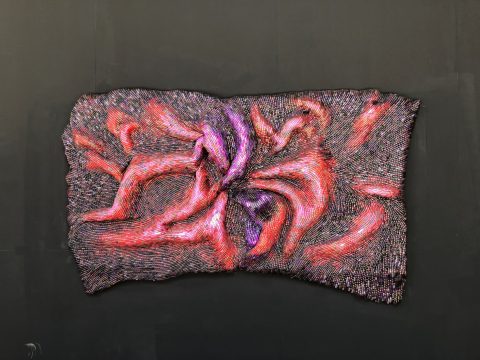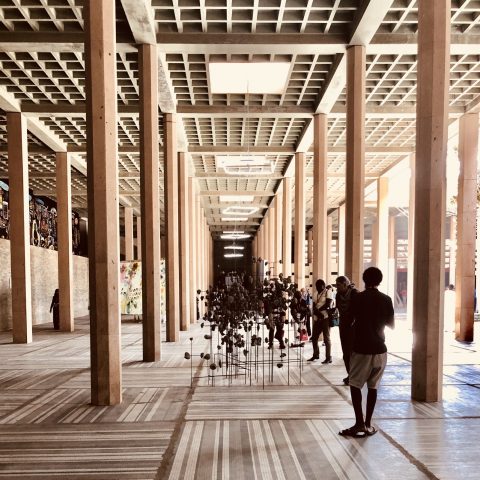The Red Hour has come at Dak’Art
Few collectors have attended the opening of the 13th edition of the Dakar Biennale of Contemporary African Art (Dak’Art), but Art Basel was there, along with some expert mushroom hunter…
- Marcos Lora Read. La Casa Roja de Caronte (2018). Installatio view. DAK’ART 2018.
- Ibrahim Ahmed, Only Dreamers Leave (2016-2017). Installation view. DAK’ART, 2018.
- Laeila Adjovi, series “Malaika Dotou Sankofa” (2016). DAK’ART 2018.
- Glenda León, Tiempo Perdido/Wasted Time (2013). DAK’ART, 2018.
- Frances Goodman, Rolling Red (2018). DAK’ART, 2018.
- Paul Alden Mvoutoukoulou, Urgencies (2017). Installation view. DAK’ART, 2018.
- Barhélémy Toguo, A Book is My Hope (2018). DAK’ART, 2018.
- Pascale Monnin, Elévation, Matthew (2016). Installation View. DAK’ART, 2018.
- Ledelle Moe, Lament (2018). DAK’ART, 2018.
- Rina Ralay-Ranaivo, Lettres aux adsentes (2016). Installation View. DAK’ART, 2018.
The official inauguration of the 13th edition of Dak’Art, mother of all African art Biennales, took place last Thursday at Grand Theatre in Dakar, Senegal. Sorrounded by guards wrapped in red cloaks, the star of the celebration was the Senegal’s president Macky Sall who, after the pompous opening speech, gave the floor to Simon Njami, the Biennial’s returning artistic director. This latter, with a possibly ostentible undestatement, enchanted the public by presenting the theme the Dakar Biennale of Contemporary African Art 2018 is centered around, that is L’Heure Rouge (The Red Hour). This expression is borrowed from a 1960s play by Martinican writer, surrealist poet and politician Aimé Cèsaire, forefather of Negritude. Besides its contemporary creation, ‘The Red Hour – Njami said – stresses the necessity of real emancipation, freedom and responsibility that Africa should take, here and now’. He also said that a New Humanity – that is the title of the international exhibition – corresponds to the ‘decisive moment’ that photographer Henri Cartier-Bresson described as the essential one in order for a picture to succeed, thus representing the linkage between present and future.
At first, the real ‘Red Hour’ (actually, two) was that spent by the many visitors waiting under the burning sun for entering the Pavillions dedicated to the art of the hosting state, Senegal, and of its two guests of honour, Tunisia and Rwanda, after the visit of the Senegal’s President and his top dogs. Entertained during the wait by the tam-tam and dances of the National team football supporters in view of the next World Cup in Russia, everyone was then a bit disappointed, so to speak, when visiting the (decent) space proposed by Tunisia, or the (just barely acceptable) one by the hosting nation. With regards to Rwanda, the candour of the exhibited art was almost touching, which seemed to be used more as a tourist office’s advertising tool of a reconciled and optimistic country.
After all, the real Biennale opened the door the same afternoon when the extraordinary Njami led the guests into the stunningly surreal scenario of the Ancient Palais de Justice, a decadent 1970s building usually housed by squatters. Until next 2nd June this will be the main venue which – together with other 5 equally charming ones called IN, curated by as many guest art connoisseurs – will exhibit the works of 75 artists from 33 states around the world. Notwithstanding Njami’s prophetic calm, a sense of urgency could still be grasped: workers were leaving the building while the visitors were entering, welcomed by those artists, in tears, who regretfully decided to show videos, which were working on and off due to power surge.
All the same, the selection of works, from those by established artists like El Anatsui and Kara Walker to emerging ones, has demonstrated a detachment from the reducing label of “african art”. The public’s attention was captured by the poetic installation ‘La Casa Roja de Caronte’ by Dominican Marcos Lora Read, consisting of a boat and a house floating in the air, which was located in a yard of the palace, and masterfully dialogued with the 30 flags of the work ‘Only the dreamers leave’ by the young Egyptian emerging artist Ibrahim Ahmed. The theme of leaving or staying has also characterised the series of ‘winged’ photographs by the French-Beninese artist and photojournalist Laeila Adjovi, winner of the Biennale’s Grand Prix Léopold Sedar-Senghor. The installation by Nigerian artist Ndidi Dike, which reflects on post-colonialism and the control of the continent’s natural resources, between local tradition and global consumerism, was also very impressive. Like ‘Wasted time’ by Cuban Glenda Léon, who ponders over the ephemeral nature of life and time. Joyful artworks were not lacking either, like the fascinating panel ‘Rolling Red’ made of fake nails seen as an extension of the body or the human figures made of blister packs by Congolese artist Paul Alden Mvoutokoulou, that is an optimistic foreshadowing of medications available for every African.
Next to IN venues (the most interesting one being in the spaces of IFAN, the Museum of African Arts, where you can see the extraordinary installation by Ghanaian super star Ibrahim Mahama), there is also a project referred to as OFF, with about 250 other venues involved. Visiting all of them may be quite a challenge. Yet, we do recommend the monumental installation at the Librarie Quatre Vents titled ‘A book is my hope’ by Cameroonian Barthélémy Toguo. The artist links Fahrenheit 451 with the desperate attempt to save the Timbuktu library from islamic fundamentalists. On the other hand, the many spontaneous projects that people created in the city are also very effective, probably because of their simplicity.
In terms of public, there weren’t as many collectors around (was it because of Frieze NY occurring at the same time?) as art advisors – like the small ‘army’ sent by Nigerian mega-collector Sindika Dokolo, who is planning to open his museum of African Art in Lisbon next year. The presence of Ralph Rugoff, artistic director of the 2019 Venice Biennale was quite significant as well as the official presence of Art Basel, which has hosted for the first time, at the eve of the opening, a dinner in honour of Simon Njami with many vip from its list attending: gallerists, artists and (again quite few) collectors. “Only two years ago, this would not have been possible” explains Marina Mottin, head of Art Basel VIP relations Africa. “Now, however, also following the birth of museums like Zeitz Mocaa in Cape Town and Macaal in Marrakech, it seems the ‘Red Hour’ has come also for a mature and extremely competent African market.”
Despite the shocking declaration made by the French president Macron not long ago concerning the repatriation of African artifacts to their original countries, it appears that the Red Hour for this promise to come true is still far away. Apparently, the muddled burocaracy and the aleatory funds of the Senegalese state apparaturs which supported the Biennale have made the whole organization a fiasco, as bluntly stated by Bonaventure Soh Bejeng Ndikung, curator of the exhibition at IFAN. And this experience is not really promising for a proper response of the African states with regards to those works which, who knows how and when, will be returned. So much as that also Simon Njami dismissed Macron’s pledge as “foolish promise”.
May 11, 2018











